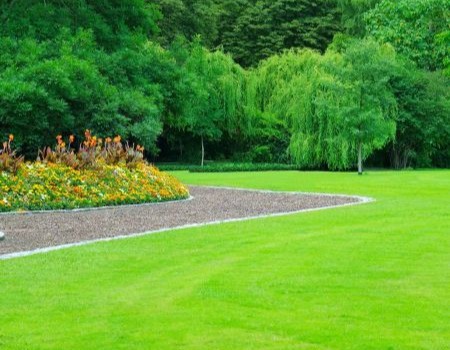
Lawn Care In Tyrone, GA: How Tyrone Homeowners Can Prepare Their Lawns For Winter

Winter here is usually mild, yet a few cold snaps can still stress grass, compact soil, and dull curb appeal. Partnering with a trusted team for professional lawn care services before the first hard freeze helps lawns in Tyrone, GA, handle temperature swings and come back strong in spring.
From neighborhoods near Shamrock Park to cul-de-sacs closer to Peachtree City and Fayetteville, most lawns in this part of Fayette County grow on red clay that holds water, then tightens as it dries. That cycle can squeeze roots, which is why a thoughtful winter plan focuses on turf health, soil structure, and water control.
Why Winter Preparation Matters In Tyrone’s Climate
Our area sits in a transition zone where warm-season bermuda and zoysia go fully dormant while cool-season tall fescue stays partly active. A quick shift from a rainy 50-degree afternoon to a 25-degree night can burn leaf tips and stress shallow roots.
Schedule service before the first hard freeze to help protect turf, irrigation parts, and soil from sudden temperature drops. Even if snow is rare, repeated light frosts still damage grass crowns, especially on slopes, shaded areas, and high-traffic corners by driveways.
What A Professional Winter Lawn Plan Includes
Your crew builds a plan around grass type, shade, foot traffic, and drainage. The goal is to help the lawn rest cleanly, avoid disease, and hold nutrients for a faster green-up in early spring.
- Seasonal mowing adjustments that protect crowns and reduce matting as growth slows.
- Strategic leaf and debris clearing to improve airflow and reduce winter disease risk.
- Targeted nutrition and soil health support based on grass type and recent weather.
- Pre-emergent and spot control timing to limit early spring weeds.
- Irrigation shutoff and system safeguards before freezing nights.
Each property is different, and timing varies by lawn size, slope, shade, and exposure to wind. Ask your provider which pre-emergent and nutrition approach fits your turf and soil so treatments land at the right time.
Timing Around First Frost And Cold Snaps
In Tyrone, the first frost often arrives in late October or November, then comes and goes through winter. Crews watch the forecast and plan visits between rain events, so the soil is firm enough to support equipment without leaving ruts.
If your yard backs up to woods or a creek, cold air can settle there earlier than at the street. Corner lots that face wind, like those along Senoia Road, can also frost faster. Avoid walking or mowing on frost-covered grass because frozen blades can crack and break under foot traffic.
Warm-Season And Cool-Season Lawns In Fayette County
Warm-season bermuda and zoysia turn straw-brown in dormancy, which is normal. The focus in winter is on clean surfaces, disease prevention, and root-zoned nutrition that sets the stage for a smooth spring transition.
Tall fescue, common in shadier spots, keeps some color through winter. It benefits from careful debris removal, moisture control, and tailored nutrition that supports the plant without pushing soft, frost‑sensitive growth.
Soil, Drainage, And Compaction On Red Clay
Red clay holds water, then tightens as it dries, which can squeeze roots if traffic stays heavy during wet spells. Your provider will check for low spots near downspouts, at mailbox edges, and beside patios where foot paths form during the holidays.
- Redirected runoff reduces pooling that leads to winter disease and spring weeds.
- Edge protection, clean borders, and tidy bed lines make dormant turf look intentional.
If you recently added hardscape, ask the crew to reassess water flow across the lawn. A small elevation change can channel more runoff into one stretch, creating muddy areas that scar the turf as it sleeps.
Irrigation Shutoff And Water Management When Temperatures Dip
Irrigation lines and backflow preventers are vulnerable once nights settle near freezing. Your lawn care team will shut the system down at the valve, insulate exposed parts where needed, and confirm controllers are off so a timer does not run during a cold snap.
Even a brief early-morning run on a 30-degree day can glaze shaded turf and increase breakage. In wetter winters, the ground already stays moist, so managed dry-down helps roots breathe and reduces disease pressure until spring.
Quick local insight: Tyrone’s red clay can stay saturated after back-to-back rains, then freeze overnight. Scheduling service visits between storms helps protect the soil surface and keeps dormant turf from getting rutted by equipment or foot traffic.
Protecting Edges, Beds, And High-Traffic Areas
Edges near sidewalks, mailboxes, and driveways take a beating during holiday traffic and deliveries. Your provider may reinforce those sections with tighter edging, debris clearing, and a plan to limit wear in the same footprints all winter.
Mulch rings around trees and beds create clean, finished lines while guarding roots from temperature swings. This also keeps string trimmers away from bark in late fall when plants are more sensitive.
How Pros Measure Success Over Winter
Winter care is about quiet progress you can see when spring arrives. In March and April, look for even color return on warm-season turf, fewer thin patches near shade lines, and fewer weeds where pre-emergent and clean surfaces worked together.
If your lawn has trouble spots, crews often document them with photos during winter visits. Those notes flow into spring plans so the team can address the exact areas that lag.
Planning Ahead For A Better Spring Green-Up
Think of winter as the foundation for everything that follows. When the surface stays clean, water moves correctly, and the root zone remains protected, you get fewer setbacks and a stronger spring start.
Homeowners who want one simple place to coordinate the entire seasonal plan often start with full-service care. Learn how a complete program can support your yard by exploring lawn care services that match your property and goals.
Choosing A Local Partner You Can Reach Quickly
Service matters when the weather changes fast. If a cold night pops up after a warm week, you want a team that monitors forecasts, adjusts schedules, and communicates clearly.
It also helps to work with a nearby provider who knows the microclimates from Peachtree City to Tyrone’s quiet cul-de-sacs. For an overview of our approach and values, read more about lawn care in Tyrone, GA, and how a neighborhood-first mindset supports consistent results.
What To Expect On A Winter Visit
Crews arrive with a checklist tuned to your lawn’s grass type, shade, and traffic. They confirm mowing height targets for late fall, plan nutrition and weed control, and verify that irrigation parts are protected before freezing nights.
They also walk the property to spot compaction patterns near gates and side yards. Notes from those walks feed the spring plan, so aeration, seeding decisions for fescue areas, and early-season weed control line up with what your lawn just experienced.
Get ahead of the first hard freeze and keep your yard looking cared for all winter. Call Lush Lawn Scapes LLC at 404-423-3431 to schedule your winter lawn visit today.
